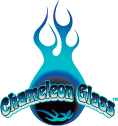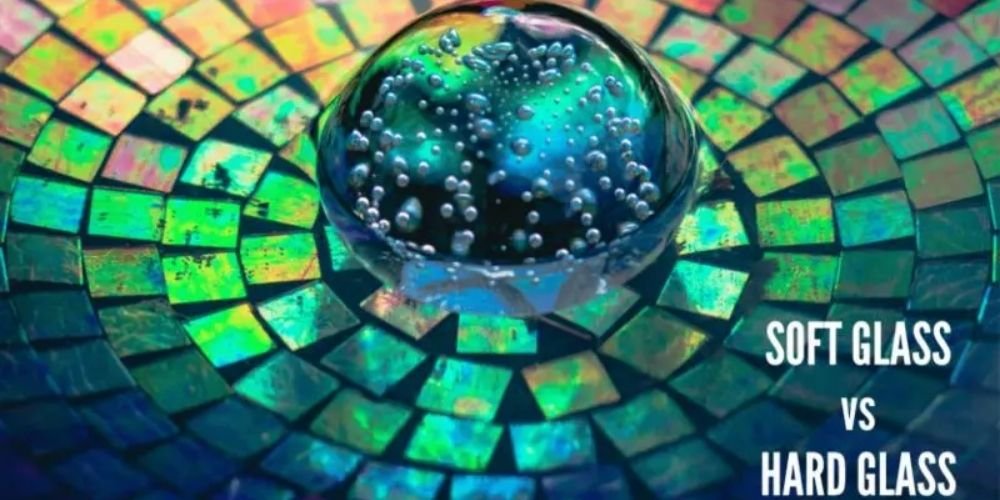Soft Glass vs Hard Glass
When it comes to glass, there are more types and varieties than you might imagine. Colors, clarities, consistencies, and applications for which they are best suited, are all different. Many of these differences have to do with temperature of manufacture and temperature of application. All commercial grade glass expands in heat and contracts in cold like most other materials.
The amount of this expansion and contraction is important to the chosen application of the glass and is measured. The measurement is called the coefficient of expansion or COE. Knowing the basic differences in glass types is helpful and can help you determine what type of glass, soft or hard, is best for you.
What is Soft Glass?
Calcifers Sand Castle With Dichro Ribbon Glass Water Pipe #723-BSoft glass, also called soda-lime glass, is the most ubiquitous of all glass recipes. Soft Glass can be manufactured and formed at much lower temperatures than other types of glass and is therefore the most economical for commercial use. Soft Glass has a very high COE and is not thermally (expansion or contraction) or percussively (drop) protected. It is most commonly used in glass bottles because bottles need to be neither heat nor shock resistant.
If you drop your beer, meh, no big deal, go get a new one at the bar. If you drop your vial of Nitro-Glycerin, that’s a much larger problem than that beer. As a consumer good, the manufacturing process is highly automated and the factories never shut down to keep the cost of production low.
Soft glass is also used to create other economically appropriate products like ‘float’ glass for windows, ‘rolled’ glass for decorative objects or ‘blown’ glass for vessels. The higher expansion rate makes it easier to be manipulated and shaped into the desired final form at lower temperatures (lower cost). Glass pipes are rarely made of Soft Glass because of the constant heating and cooling requirements of the application. Alright, who bogarted my lighter?
What is Hard Glass?
Hard glass, also called borosilicate (boro) or Pyrex glass, is used in temperature dependent applications like baking dishes and strength dependent or high-pressure applications for marine and military. This type of glass is more dense because it is not just mixed together like soft glass. Boro is doped with Boron.
Doping a material means heating to such a high temperature that space is made between the molecules for the doping agent (boron) so that when it cools, the Boron acts like it is part of the glass. Borosilicate is designed to withstand abuse and high heat. It is used to make things that are multi-purpose and can handle a bit more ‘action’.
The lower expansion rate lends itself to products that are exposed to high heat or repetitive heating and cooling. Boro is favored to create the protective re-entry surfaces on space vehicles, periscopes in submarines and that Chameleon Glass Pipe you’re about to spark up. Go ahead, take a rip, I’ll wait.
That means the glass in my car is hard glass, right? Wrong. Automobiles, a consumer good in high production, utilizes two kinds of soft glass. For the windshield, 2 sheets of soft glass are used to ‘sandwich’ a layer of ballistic polymer between them. It will crack, but does not shatter. The side and rear windows are tempered soft glass. Tempering glass involves a higher-than-normal temperature for pouring and a controlled, quick cooling process that leaves the glass ‘stronger’, but only to a point where it shatters completely.
The Better Glass?
There is actually no way to determine which type of glass is best, as it truly depends on the type of final product you want. If you are working on a vase that is delicate and ornate, it is better to use soda-lime glass or soft glass. If you are trying to make a dish you can cook with or can use in the oven, you had better use hard glass.
There is a range of types of glass pipes, and determining the best glass for the application is going to depend on what you want the glass to ultimately do.
What do we Use for our Glass Pipes?
Chameleon Glass creates and sells a range of beautiful glass pipes that are decorative and truly stunning. These pipes are handcrafted, fully functional, and beautiful as collectible display pieces to boot. These pipes are great for those who want a beautiful piece of functional art as a part of their collection.
We create attractive Chameleon Bongs, glass chillums as well as other pipes like critter glass pipes in plenty of designs and shapes so that you can find the piece that works for you.
Chameleon Glass pipes are made from hard glass and are expertly hand sculpted and designed in a way that they are both functional as well as beautiful to admire.
FAQ
Is soft glass easier to clean than hard glass or vice versa?
Both soft and hard glass pipes are easy to keep clean, and have very similar properties when it comes to heating, the main differences come from durability and resistance to thermal shock. Learning the best methods for cleaning a glass pipe will go a long way with either type.
Is hard glass more durable than soft glass?
Yes, hard glass or borosilicate is denser and more resistant to not only thermal shock or being heated and cooled repeatedly, but also mechanical shock, as in drops and impacts. This is why pipes which are constantly heated and cooled, are preferably made in hard glass, while large bongs which are filled with water, and generally don’t see as much temperature change, can be made from either type.
Chameleon’s Featured Soft Glass Bongs
Chameleon’s Featured Soft Glass Bong




Leave a Reply
You must be logged in to post a comment.